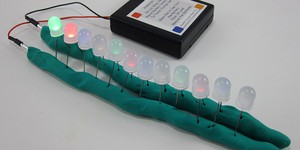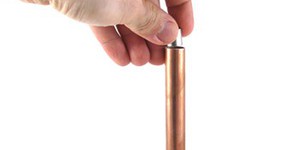First Grade, Electricity & Electronics Science Projects (6 results)
Stop for a minute and try to imagine your world without electrical power and electronic gadgets.
No convenient appliances in the kitchen, no electric lights. No computers, MP3 players, television, or video games.
Your life would be completely different, wouldn't it? Electricity and electronics are so central to modern life that, paradoxically, they're easy to overlook.
|
Select a resource
Coding Projects
Sort by
|
Do you like playing with play dough; or modeling clay? Wouldn't it be cool if you could add lights, sound, or even motion to your play dough creations? In this project, you will use play dough that conducts electricity, which will allow you to connect lights to your sculptures!
This project is the first in a three-part series on play dough circuits, which can all be done with the same materials. We recommend doing the projects in order.
Read more
What do you do with your old wooden pencils when they get too short to hold? Don't throw them away; you can use them to make circuits! This project will show you how to use pencils to make resistors, an important part of many electrical circuits, and test how they affect the brightness of a lightbulb in a simple circuit.
Read more
New
Have you ever seen a waiter balance an entire tray of drinks without spilling any? How do they do it? Do you think you could build a robot waiter that can do the same thing? In this project, you will learn how to build a self-balancing robotic tray. You can incorporate the auto-leveling tray into one of our many other robotics projects, like the Bluebot or robotic arm.
Read more
A tried and true balloon activity is to rub a balloon on your head to make your hair stand up. How does the rubbing build up static electricity? Do this experiment to see if the number of rubs makes a difference.
Read more
Electricity powers many of the devices we use every day, from lights to video games and computers. Engineers have to use certain materials to make electrical devices work. In this experiment, you will find out which materials let electricity flow through them (conductors) and which ones prevent electricity from flowing through them (insulators).
Read more
Have you tried our first electric play dough project,
and now you are looking for more to do? Do you want to learn more about circuits and add even more lights? Check out this project for part 2 of our play dough circuits series!
Read more
New
How do you feel right now? Do you remember how you felt a few hours ago? How about yesterday or last Wednesday? What if you could track your emotions throughout the day and use this information to help improve your mood and well-being? In this science project, you will program a simple, pocket-sized device that you can carry around with you to log your feelings whenever you want or on a specific schedule.
Read more
Did you know that not all trains run on tracks? Some of the world's fastest trains are magnetic levitation trains (maglev). This means that the carriage of the train is suspended over the rails with no support, but only with magnetic fields! There is a physical explanation for magnetic levitation, and if you would like to learn more about magnetism and current, this is a science fair project that you must try!
Read more
|














